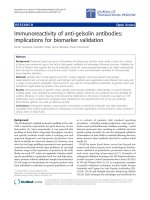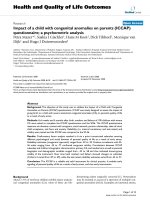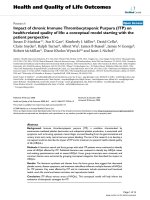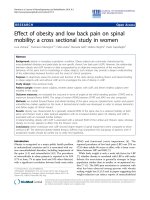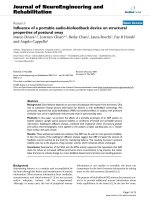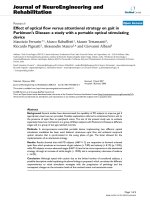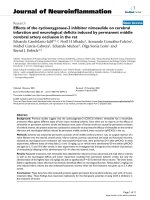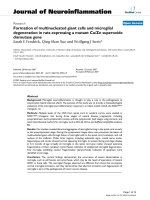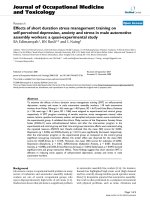Báo cáo hóa học: " Formation of silicon nanodots via ion beam sputtering of ultrathin gold thin film coatings on Si" pot
Bạn đang xem bản rút gọn của tài liệu. Xem và tải ngay bản đầy đủ của tài liệu tại đây (2.79 MB, 5 trang )
NANO EXPRESS Open Access
Formation of silicon nanodots via ion beam
sputtering of ultrathin gold thin film coatings
on Si
Osman El-Atwani
1,2*
, Sami Ortoleva
3
, Alex Cimaroli
4
and Jean Paul Allain
1,2,4
Abstract
Ion beam sputtering of ultrathin film Au coatings used as a physical catalyst for self-organization of Si
nanostructures has been achieved by tuning the incident particle energy. This approach holds promise as a
scalable nanomanufacturing parallel processing alternative to candidate nanolithography techniques. Structures of
11- to 14-nm Si nanodots are formed with normal incidence low-energy Ar ions of 200 eV and fluences above 2 ×
10
17
cm
-2
. In situ surface characterization during ion irradiation elucidates early stage ion mixing migration
mechanism for nanodot self-organization. In particular, the evolution from gold film islands to the formation of
ion-induced metastable gold silicide followed by pure Si nanodots formed with no need for impurity seeding.
Nanostructuring of semiconductor surfaces via ion beam
sputtering has been shown to yield a variety of ordered
nanostructures [1-3]. While there is speculatio n about
the mechanism of nanostructure evolution on com-
pound semiconductors, the structuri ng of single-compo-
nent semiconductor materials, and more specifically
silicon, remains elusive. Although structuring of silicon
surfaces using ion beam bombardment at normal inci-
dence was first reported by R. Gago et a l. [4], studies,
later on, have shown that structuring of silicon dots on
silicon surfaces at zero incidence angle is possible only
if a certain level of impurity is available on the surface
during the sputtering process [5]. Moreoever, other stu-
dies have shown that irradiating silicon surfaces with no
impurity seeding results in s urface smooth ing at normal
incidence [6,7], in contradiction to the results of R.
Gago et al. T he role of impuriti es, which usuall y comes
from the ion gun and the clips holding the samples, was
discussed by Ozaydin et al. [8,9] and Sanchez-Garcia et
al. [10] who suggested several mechanisms on how
impurity seeding can induce nanostructure formation on
silicon. The formation of silicides, modification of the
collision cascade, and stress generation during ion bom-
bardment were the suggested possible impurity effects
on silicon nanostr ucturing. In this work, we report the
formation of s ilicon nanodots on silicon substrates via
low-energy ion irradiation of ultrathin film gold coatings
onSi.NoimpurityseedingwasnecessarytoformSi
nanostructures. The gold acted as a physical catalyst to
form the structures, which was later eliminated from Si
nanostructures via preferential sputtering. This process
is unlike the previous studies where the impurities are
kept implanted in the samples due to the continuous
seeding of impurity particles from ion source grids or
sample grips throughout the irradiation process.
Silicon (100) samples were prepared by cleaning sili-
con wafers with Piranha solution (1:1, hydrogen perox-
ide, sulfuric acid) and subsequent acetone, water, and
alcohol baths, followed by coating with gold using an
SPI sputter coater. Irradiation and the in situ characteri-
zation of the samples were performed in the same
chamber at a pressure of 2 × 10
-8
Torr. Irradiation was
performed with 200 eV of argon ions using a low-
energy, broad beam ion source. The temperature of the
silicon samples was kept at nearly room temperature
with active cooling. During the irradiation process, the
samples were characterized in situ with X-ray photoelec-
tron spectroscopy (XPS) and ion scattering spectroscopy
(ISS) at different fluences. XPS scans were performed
with a source analyzer angle of 54.7°. A nonmonochro-
matic Mg Ka (1,245.3 eV) X-ray source was used with
an anode voltage of 13.0 kV and an emission current of
* Correspondence:
1
School of Materials Engineering, Purdue University, West Lafayette, IN
47907, USA
Full list of author information is available at the end of the article
El-Atwani et al. Nanoscale Research Letters 2011, 6:403
/>© 2011 El-Atwani et al; licensee Springer. This is an Open Access article distributed under the terms of the Creative Commons
Attribu tion License ( which permits unrestricted use, distribution, an d reproduction in
any medium, provid ed the original work is properly cited.
15.0 mA. An ISS characterization was performed using a
1,500-eV He
+
and a backscattering angle of 145°. The
total probing beam current was 150 nA corresponding
to a maximum flux of 1.4 × 10
13
cm
-2
s
-1
.
In situ XPS and ISS were executed using a VG Scienta
R3000 charged particle analyzer (VG Scienta, Uppsala,
Sweden). Ex situ scanning electron microscopy (SEM)
characterization of gold-coated silicon and of nanostruc-
tured silicon (after irradiation) were perfor med using an
ex situ H4800 field emission SEM (Hitachi High Tech-
nologies America, Inc. Schaumburg, IL, USA). The
quantification of the XPS and LEIS S peaks was per-
formed using the CasaXPS and IGOR Pro software
packages, respectively. At each fluence, the relative con-
centration of gold using LEISS data was calculated using
the following equation:
y =
A
Au
σ
Au
A
Au
σ
A
u
+
A
Si
σ
S
i
(1)
where A
Au
and A
Si
are the areas under the curves of
Au and Si, respectively, and s
Au
and s
Si
are the labora-
tory elastic scattering cross sections of Au and Si,
respectively.
Figure 1a shows the spatial profile along a horizontal
line to the sample surface with XPS core level peaks of
Au 4f and Si 2p. The postirradi ation data shown in Fig-
ure 1b and corresponding ex situ SEM images (Figure
1c,d) show the effect of the Au coating. An examination
of the XPS spectrum in Figure 1b shows no sign of Au,
yet the SEM images show nanopatterning only on the
region where the Au was deposited. In that region,
nanostructures with a diameter of roughly 11-14 nm
were formed. Figure 2 shows a magnified image of the
silicon dots after the irradiation process. To understand
how the gold film affected the nanostructure formation,
in situ XPS and LEISS were performed during the irra-
diation process on another sample fully coated with 10-
nm gold. It should be noted here that while XPS is cap-
able of probing the top 1-5 nm of the surface, LEISS
probes only the first layer [11,12].
Figure 3a shows the in situ LEISS data. Before irradia-
tion, the sample shows no silicon, and after a fluence of
about 3 × 10
16
cm
-2
,themixingbetweengoldandsili-
con begins. Since the sputtering yield of gold is higher
than silicon at 200 eV (1.13 for gold and 0.15 for silicon
as calculated from the Stoppi ng and Range of Ions in
Matter, SRIM 2008) [13], preferential sputtering occurs
until all the gold is removed, leaving silicon and a trace
of oxygen on the surface top layer of the surface. The
clear presence of gold in the ISS data up to a fluence of
about 2.3 × 10
17
cm
-2
indicate s evidence for gold-silicon
mixing.
The formation of gold silicides is a strong indication
of the mixing between silicon and gold and has been
previously discussed in the literature in the context of
xenon and krypton irradiation [14,15]. Their formation
is marked b y a 1. 0-eV shift in the XPS spectra to higher
binding energies of gold after mixing; this indicates a
reaction between gold and silicon [15]. Figure 3b shows
Figure 1 Spatial profile of the half-coated sample before and after irradiation. (a) Spatial profile of the XPS core level spectra of Au-4f and
Si-2p before Ar+ 200 eV irradiation and (b) after irradiation. Position is plotted vertically along the sample where one region has a 20-nm Au
film (top of Figure 1) and the bottom region only Si. (c-d) SEM images corresponding to the postirradiation condition for the Au-coated (c) and
uncoated (d) regions. Si nanostructures are evidenced only in the region where Au was deposited noting that in (b) XPS Au-4f spectra are
absent.
El-Atwani et al. Nanoscale Research Letters 2011, 6:403
/>Page 2 of 5
the in situ XPS data. Gold 4f
5/2
and 4f
7/2
peaks were at
83.8 and 87.5 eV, respectively. After a fluence of 3 ×
10
16
cm
-2
, the peaks shifted by 1 to 84.8 eV and 88.5
eV, respectively. This shift is due to the formation of
gold silicide. The presence of the oxygen peak in the
ISS and XPS data is due to the native oxide layer on top
of the silicon present before coating the silicon sub-
strates. This layer can be eliminated at higher fluences.
To elucidate about the role of gold during the nano-
patterning process, a quantification of LEISS and XPS
spectra was performed. The quantification results
are shown in Figure 4. Both the ISS and the XPS
quantification output curves indicate two different
reduction mechanisms of gold concentration. Initially,
gold is sputtered until the 200-eV argon ions are able to
penetrate the thin gold film (penetration depth of argon
is around 2 nm
10
) and induce mixing with silicon. This
is marked by a large negative slope in t he gold relat ive
concentration versus fluence data shown in Figure 4,
region A. The gold concentration, however, was not uni-
form during this period. This is due to inhomogeneities
(islands) of the gold film confirmed by SEM, which dur-
ing sputtering, result in more silicon areas being uncov-
ered due to the dissimilar sputter yield of Au atoms
compared to Si. Furthermore, Si and Au form a eutectic
at a concentration of about 31 a/o Si-Au and tempera-
ture of 370°C. Therefore, ion-induced mixing could
effectively induce an enhanced surface diffusion that
redistributes Au from peak to valleys of the islands that
further lead to erosion of Au. Note that when surface
structures are formed, in principle, the valleys erode fas-
ter than the peaks due to the proximity of the incident
particle energy depositio n density to surface atoms
according to the Bradley-Harper and Sigmund models
[16,17].
After mixing, both gold and silicon were sputtered,
and the gold relative concentrat ion decreases much less
rapidly as marked by the higher fluence tail of the expo-
nential decay in the data (Figure 4 region B). Two
regions are observed when combining the LEISS and
XPS data in situ.Below3×10
16
cm
-2
, since the pene-
tration depth of Ar on Au is 2-3 nm at 200 eV, o nly
Figure 2 Magnif ied SEM image of Si licon nanodots after the
removal of the gold film. Image was taken after a fluence of 4 ×
10
17
cm
-2
after irradiation with 200 eV of Ar ions.
Figure 3 Surface characterization of gold and silicon in the sample. (a) In situ LEISS peaks of the three main elements on the surface of the
sample (O, Si, Au). (b) In situ XPS data of gold and silicon in the sample.
El-Atwani et al. Nanoscale Research Letters 2011, 6:403
/>Page 3 of 5
monoelemental sputtering is the dominant erosion
mechanism. However, binary collision approximation
calculations show that mixing occurs at about 4 × 10
16
cm
-2
, very close to the experimental value (3 × 10
16
).
This difference is within the relative margin of error in
the ion current density measurement. After mixing
ensues at 3 × 10
16
cm
-2
, low-energy ion scattering spec-
troscopy (LEISS) results indicate higher gold concentra-
tion. This is because the mixing layer thickness is less
than the XPS probing depth. XPS probes the mixing
layer and the silicon layers underneath, thus, is more
silicon-biased. At higher fluences, however, ISS and XPS
results begin to converge due to the very small amounts
of gold left in the mixing layer. No impurities were
found on the surface during or after the formation of
the structures as revealed from the XPS and ISS data.
Although the sputter yield of Au is ten times that of Si,
we speculate the dominant Au concentration at the top
1-2 monolayers (along the surface nanostructures) com-
pared to the subsurface which is likely due to the ion-
induced segregation mechanism since the gold surface
tension is known to be lower than Si.
After the first stage of erosion of the gold film, the
second stage follows with the formation of gold silicides
as indicated by the XPS data. It is well-known that gold
silicide formation dominates at the bottom of the island
or the Au/Si interface [18]. We conjecture that after the
formation of differential silicide regions at the Au/Si
interface, sputtering occurs at different rates (the silicide
regions sputtering less), and thus nanostructures are
effectively self-organized primarily dominated by Si.
Silicides can sputter less mainly due to the enhanced
binding that occurs in these cases. For example, Silicides
are known to sputter about a factor of two to four times
less than the pure metal component [19]. In t he third
and last stage at large flue nces, the Au is sputtered
away, and only silicon nanostructures remain.
In conclusion, silicon nanodots can be formed via low-
energy ion irradiation without permanent impurity
implementation. This was achieved by irradiating gold-
coated silicon surfaces with argon ions at 200 eV, where
gold acted as a catalyst during t he nanopatterning pro-
cess and was eliminated from the silicon samples after
the formation of the nanodots. Silicide formation
and preferential sputtering of the silicon surfaces after
the gold silicide formation are the two phenomena that
govern the nanodot formation process.
Author details
1
School of Materials Engineering, Purdue University, West Lafayette, IN
47907, USA
2
Birck Nanotechnology Center, Purdue University, West Lafayette,
IN 47907, USA
3
School of Electrical Engineering, Purdue University, West
Lafayette, IN 47907, USA
4
School of Nuclear Engineering, Purdue University,
West Lafayette, IN 47907, USA
Authors’ contributions
OE and JPA planned and prepared the design of the experiment. OE, SO,
and AC prepared the samples and carried out the irradiations, the LEISS and
XPS characterizations. OE performed the morphology characterization with
SEM. OE, SO, AC, and JPA interpreted the results and contributed to the
effort of writing the manuscript.
Competing interests
The authors declare that they have no competing interests.
Received: 5 February 2011 Accepted: 31 May 2011
Published: 31 May 2011
References
1. Facsko S, Dekorsy T, Koerdt C, Trappe C, Kurz H, Vogt A, Hartnagel HL:
Formation of Ordered Nanoscale Semiconductor Dots by Ion Sputtering.
Science 1999, 285:1551.
2. Hanisch A, Biermanns A, Grenzer J, Facsko S, Pietsch U: Xe ion beam
induced rippled structures on differently oriented single-crystalline Si
surfaces. J Phys D: Appl Phys 2010, 43:112001.
3. Chappert C, Bernas H, Ferre J, Kottler V, Jamet JP, Chen Y, Cambril E,
Devolder T, Rousseaux F, Mathet V, Launois H: Planar Patterned Magnetic
Media Obtained by Ion Irradiation. Science 1998, 280:1919.
4. Gago R, Vazquez L, Cuerno R, Varela M, Ballesteros C, Albella JM:
Production of ordered silicon nanocrystals by low-energy ion sputtering.
Appl Phys Lett 2001, 78:3316.
5. Ozaydin G, Özcan AS, Wang Y, Ludwig KF, Zhou H, Headrick RL,
Siddons DP: Real-time x-ray studies of Mo-seeded Si nanodot formation
during ion bombardment. Appl Phys Lett 2005, 87:163104.
6. Carter G, Vishnyakov V: Roughening and ripple instabilities on ion-
bombarded Si. Phys Rev B 1996, 54:17647.
7. Zhou J, Facsko S, Lu M, Moller W: Nanopatterning of Si surfaces by
normal incidention erosion: influence of metal incorporation on surface
morphology evolution., arXiv:1002.1002v1.
8. Ozaydin G, Ludwig KF Jr, Zhou H, Headrick RL: Effects of Mo seeding on
the formation of Si nanodots during low-energy ion bombardment.
J Vac Sci Technol B 2008, 26:551.
9. Ozaydin G, Ludwig KF Jr, Zhou H, Zhou L, Headrick RL: Transition behavior
of surface morphology evolution of Si (100) during low-energy normal-
incidence Ar
+
ion bombardment. J Appl Phys 2008, 103:033512.
Figure 4 Relative concentration of gold. Relative concentration of
gold in the sample during irradiation as a function of fluence after
LEISS and XPS quantification. The plot of relative concentration (%
Au) versus fluence displays two regions (A and B). Gold sputtering
takes place in region A, whereas gold-silicon mixing and preferential
sputtering of gold occurs in region B. The upper right inset is a
magnification of the split between regions A and B.
El-Atwani et al. Nanoscale Research Letters 2011, 6:403
/>Page 4 of 5
10. Sanchez-Garcia JA, Vazquez L, Gago R, Redondo-Cubero A, Albella JM,
Czigany Z: Tuning the surface morphology in self-organized ion beam
nanopatterning of Si(001) via metal incorporation: from holes to dots.
Nanotechnology 2008, 19:355306.
11. Smits RHH, Seshan K, Ross JRH, van den Oetelaar LCA, Helwegen JHJM,
Anantharaman MR, Brongersma HH: A Low-Energy Ion Scattering (LEIS)
Study of the Influence of the Vanadium Concentration on the Activity of
Vanadium-Niobium Oxide Catalysts for the Oxidative Dehydrogenation
of Propane. J Catal 1995, 157:584-591.
12. Jenks CJ, Ross AR, Lograsso TA, Whaley JA, Bastasz R: Angle-resolved low-
energy ion scattering studies of quasicrystalline Al-Pd-Mn. Surface Science
2002, 521:34-42.
13. SRIM-2008 software package. [].
14. Khalfaoui R, Benazzouz C, Guittoum A, Tabet N, Tobbeche S: Irradiation-
induced gold silicide formation and stoichiometry effects in ion beam-
mixed layer. Vacuum 2006, 81:45-48.
15. Kumar S, Sahoo PK, Chauhan RS, Kabiraj D, Tiwari U, Varma D, Avasthi DK:
Mixing in Au/Si system by nuclear energy loss. Nucl Instr and Meth in
Phys Res B 2003, 212:238-241.
16. Sigmund P: A mechanism of surface micro-roughening by ion
bombardment. J Mater Sci 1973, 8:1545.
17. Bradley RM, Harper JM: Theory of ripple topography induced by ion
bombardment. J Vac Sci Technol A 1988, 6:2390.
18. An DK, Madl K, Barna A, Battisitig G, Gyulai J: The simulataneous diffusion
of gold and boron into silicon. Phys Stat Sol A 1989, 116:561.
19. Yoshitake M, Yamauchi Y, Bose C: Sputtering rate measurements of some
transition metal silicides and comparison with those of the elements.
Surf Interface Anal 2004, 36(8):801.
doi:10.1186/1556-276X-6-403
Cite this article as: El-Atwani et al.: Formation of silicon nanodots via
ion beam sputtering of ultrathin gold thin film coatings on Si. Nanoscale
Research Letters 2011 6:403.
Submit your manuscript to a
journal and benefi t from:
7 Convenient online submission
7 Rigorous peer review
7 Immediate publication on acceptance
7 Open access: articles freely available online
7 High visibility within the fi eld
7 Retaining the copyright to your article
Submit your next manuscript at 7 springeropen.com
El-Atwani et al. Nanoscale Research Letters 2011, 6:403
/>Page 5 of 5
